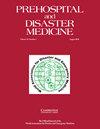美国好撒玛利亚人法中的出血控制保护措施
IF 2.5
4区 医学
Q2 EMERGENCY MEDICINE
引用次数: 0
摘要
导言:在美国,50 个州和哥伦比亚特区都有好撒玛利亚人法(Good Samaritan Laws,GSLs)。好撒玛利亚人法旨在鼓励旁观者在紧急情况现场施以援手,如果善意提供护理,好撒玛利亚人法一般会限制民事侵权责任的风险。在全国范围内,可预防死亡的一个主要原因是未控制的外伤出血。公共出血控制倡议旨在培训公众识别危及生命的体外出血、执行维持生命的干预措施(包括直接按压、使用止血带和伤口包扎),并促进出血控制设备的使用,以确保旁观者做出快速反应。方法:本研究旨在确定各州和哥伦比亚特区的 GSL,以确定法律涵盖了哪种类型的急救人员(例如,所有非专业人员、仅受过培训的人员或仅有执照的医疗保健提供者),以及其 "好撒玛利亚人 "覆盖范围是否明确包括或排除了出血控制。结果:在所有 50 个州和哥伦比亚特区都发现了提供民事责任限制性豁免的《撒玛利亚好人法》。俄克拉荷马州明确将出血控制纳入其《好撒玛利亚人法》。康涅狄格州、伊利诺伊州、堪萨斯州、肯塔基州、密歇根州和密苏里州等六个州的法律规定了 "好撒玛利亚人 "豁免权的保护对象,一般仅限于接受过标准急救或复苏课程培训的个人或医疗保健临床医生。没有一个州明确将止血排除在 GSL 之外,有一个州明确将其包括在内。结论:在美国全国范围内,大多数州都在 GSL 范围内为包括出血紧急情况在内的各类紧急医疗状况提供了广泛的旁观者保护,没有任何一个州明确将出血控制干预措施排除在外。有些州规定,只有完成特定培训计划的医护人员或旁观者才可参与。对于那些 GSL 可能不包括出血控制干预措施的州,我们有机会进行更多的研究。本文章由计算机程序翻译,如有差异,请以英文原文为准。
Bleeding Control Protections Within US Good Samaritan Laws
Introduction: In the United States, all 50 states and the District of Columbia have Good Samaritan Laws (GSLs). Designed to encourage bystanders to aid at the scene of an emergency, GSLs generally limit the risk of civil tort liability if the care is rendered in good faith. Nation-wide, a leading cause of preventable death is uncontrolled external hemorrhage. Public bleeding control initiatives aim to train the public to recognize life-threatening external bleeding, perform life-sustaining interventions (including direct pressure, tourniquet application, and wound packing), and to promote access to bleeding control equipment to ensure a rapid response from bystanders. Methods: This study sought to identify the GSLs in each state and the District of Columbia to identify what type of responder is covered by the law (eg, all laypersons, only trained individuals, or only licensed health care providers) and if bleeding control is explicitly included or excluded in their Good Samaritan coverage. Results: Good Samaritan Laws providing civil liability qualified immunity were identified in all 50 states and the District of Columbia. One state, Oklahoma, specifically includes bleeding control in its GSLs. Six states – Connecticut, Illinois, Kansas, Kentucky, Michigan, and Missouri – have laws that define those covered under Good Samaritan immunity, generally limiting protection to individuals trained in a standard first aid or resuscitation course or health care clinicians. No state explicitly excludes bleeding control from their GSLs, and one state expressly includes it. Conclusion: Nation-wide across the United States, most states have broad bystander coverage within GSLs for emergency medical conditions of all types, including bleeding emergencies, and no state explicitly excludes bleeding control interventions. Some states restrict coverage to those health care personnel or bystanders who have completed a specific training program. Opportunity exists for additional research into those states whose GSLs may not be inclusive of bleeding control interventions.
求助全文
通过发布文献求助,成功后即可免费获取论文全文。
去求助
来源期刊

Prehospital and Disaster Medicine
Medicine-Emergency Medicine
CiteScore
3.10
自引率
13.60%
发文量
279
期刊介绍:
Prehospital and Disaster Medicine (PDM) is an official publication of the World Association for Disaster and Emergency Medicine. Currently in its 25th volume, Prehospital and Disaster Medicine is one of the leading scientific journals focusing on prehospital and disaster health. It is the only peer-reviewed international journal in its field, published bi-monthly, providing a readable, usable worldwide source of research and analysis. PDM is currently distributed in more than 55 countries. Its readership includes physicians, professors, EMTs and paramedics, nurses, emergency managers, disaster planners, hospital administrators, sociologists, and psychologists.
 求助内容:
求助内容: 应助结果提醒方式:
应助结果提醒方式:


